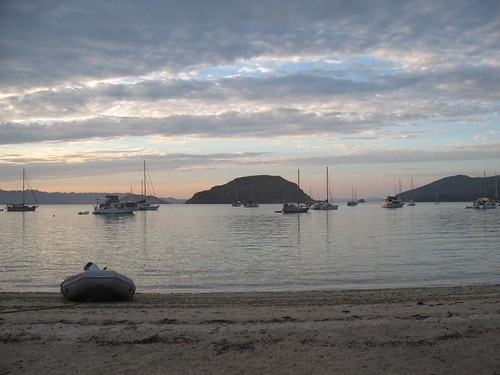
Short Answer: Supplement your LED masthead anchor light with reflective tape and sidewalk lights.
Long Story: When you live on a boat, you start to count every amp and erg and become quite resentful of energy hogging devices. In this category, the masthead anchor light is a surprising pig. By law and necessity, these lamps are very bright – at least 60 lumens for the average sail boat. An incandescent bulb will draw .8 to 2 amps per hour while an expensive LED variety will pull roughly .1 to .5 amps per hour. Translated, you'll burn through 8 to 20 amp hours a day with an incandescent anchor light or 1 to 5 with an LED. To put that into context, your average solar panel set up is only going to yield 8 to 13 amps an hour during the hottest part of the day. So the first and most obvious tip regarding the masthead anchor light is to switch to LED the next time you fly the mast. As a side note, this will probably take two trips: the first to figure out precisely what kind and size bulb you have, the second to install the new one.
But there are additional considerations when contemplating lighting your boat at night. First, can you find your boat by starlight amongst all the other similar white hulls? Second, will your lights go on automatically when it gets dark? Third, it is useful to know that pangueras do not look up. If your boat isn't lit at the water line, there's a good chance a panga will hit it.
We address all three concerns using very cheap, light-sensitive, solar-powered sidewalk lights. DrC installed mounts made of PVC and zipties on all four corners of the boat. As soon as we drop anchor, the girls drop the lights into their mounts. Our distinctive four orange points make Don Quixote easy to find and to see at night. They are so lightweight, we make a point of removing them while underway. They also do double duty as amber night lights on night passages as we stick them head down around the salon and heads.*
Another trick used by many Mexican cruisers including ourselves is to hang a high-powered LED light from the mid-boom. The law in many anchorages south of the border is not quite as strict regarding the use of an anchor light. Low power, high lumen lights closer to the deck replace high power mast lights on many boats. A little extra money and you can find solar-powered, light-sensitive models. Just don't forget to take these boom lights down before you put up the sail. And remember, you can't use them exclusively as anchor lights in the States or some highly trafficked international ports.
A final suggestion from the Don Quixote files is reflective tape. DrC placed highly reflective, silver tape strips just below the toe rails, on the transom steps, and at intervals up the mast. You can't really see the strips against the white hull and aluminum mast during the day. However, at night you need only sweep a small head lamp or flashlight in our direction and the shape of the whole boat lights up. We've repeated the treatment with our dinghy on the notion that you can never be too visible at night to passing traffic.
Note: It appears that West Marine now has a little solar sidewalk light complete with rail mount for which you will pay $49.99/each. Don't do it. Just get out your saw blade, some zip ties, and a length of PVC, and go to town.
